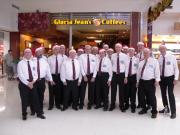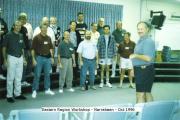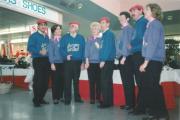The Style
Barbershop is a "melting pot" product of African-American devices, European hymn-singing, and an American tradition of recreational music. It's melodies are in the vocal and skill range of the average singer, with lyrical emphasis on simple heartfelt emotions, love and friendship.
Today
There are over 70,000 barbershop singers around the world. These are loosely connected through great camaraderie with parent associations in each Country like AAMBS (Australian Association of Men's Barbershop Singers) and BABS (British Association of Barbershop Singers). The oldest and largest 'Mother' association in America used to be called SPEBSQSA - the 'Society for the Preservation and Encouragement of BarberShop Quartet Singing in America' has recently updated it's name to 'Barbershop Harmony Society'.
Since the rebirth in 1938 of barbershop singing in America it has gradually spread around the world. Apart from the special close harmony used (click here) groups shy away from the word 'choir' since this a cappella art form is performed without manuscript and is presented often with movements to 'sell' the song.
All 'chapters' or 'choruses' are non-profit associations and donate a significant part of their time or yearly income to a chosen charity. Our chorus donates time and money to various charities. The most recent being Camp Breakaway.

History
The true origins of barbershop singing are somewhat clouded and the extent to which 'barbershop singing' is defined probably determines where the history starts.
It is true that in the sixteenth and seventeenth centuries, informal music making (both vocal and instrumental) was common in British and European barbershops. The practice declined there in the eighteenth century, but was exported to America where it steadily grew in popularity.
By the end of the nineteenth century, the barbershop quartet movement had become a strong musical tradition among amateur musicians. This type of singing involving an a cappella group of two tenors, a baritone and a bass singing arrangements of popular songs in close-position harmonies with much chromaticism flourished between 1895 and 1930. Its widespread popularity owed much to both the traveling vaudeville and variety shows of the late nineteenth century, which usually included a barbershop quartet as one of the acts, and the fledgling recording industry of the early twentieth century.
The first immigrants to the new world (USA) brought with them a musical repertoire that included hymns, psalms, and folk songs. These simple songs were often sung in four parts with the melody set in the second lowest voice.
Minstrel shows of the mid-1800s often consisted of the white singers in black face (later black singers themselves) performing songs and sketches based on a romanticized vision of plantation life. As the minstrel show was supplanted by the equally popular vaudeville, the tradition of close harmony quartets remained, often as a "four act" combining music with ethnic comedy that would be scandalous by modern standards.
The "barbershop" style of music is first associated with black southern quartets of the 1870s, such as 'The American Four' and 'The Hamtown Students'. The African influence is particularly notable in the improvisational nature of the harmonization, and the flexing of melody to produce harmonies in "swipes" and "snakes." Black quartets, "cracking a chord" were commonplace at places like Joe Sarpy's Cut Rate Shaving Parlor in St. Louis, or in Jacksonville, Florida, where, black historian James Weldon Johnson writes, "every barbershop seemed to have its own quartet."
The first written use of the word "barbershop" when referring to harmonizing occured in 1910, with the publication of the song, "Play That Barbershop Chord" - evidence that the term was in common parlance by that time.
Shortly after World War 1 the popularity of barbershop music began to wane. With increasing urbanisation, the spread of the automobile, Prohibition, the tempo of life because faster. Radio provided people with music easily and instantly, music was more dance oriented and sophisticated also less vocally suitable and folksy. The Depression of the 1930's was also a harsh blow, and the simple sweetness of barbershop harmony went into hibernation...until 1938...
The Following text is Courtesy of Heritage Hall Museum of Barbershop Harmony located in Kenosha, Wisconsin.
Birth of the Barbershop Harmony Society : the dream of O.C.Cash and Rupert Hall
While traveling to Kansas City on business, Tulsa tax attorney O.C.Cash happened to meet fellow Tulsan Rupert Hall in the lobby of the Muehlebach Hotel. The men fell to talking and discovered they shared a mutual love of vocal harmony. Together they bemoaned the decline of that all-American institution, the barbershop quartet, and decided to stem that decline.
Signing their names as "Rupert Hall, Royal Keeper of the Minor Keys, and O.C.Cash, Third Temporary Assistant vice Chairman," of the "Society for the Preservation and Propagation of Barber Shop Quartet Singing in the United States" [sic], the two invited their friends to songfest on the roof garden of the Tulsa Club, on April 11, 1938.
Twenty-six men attended that first meeting, and returned the following week with more friends. About 150 men attended the third meeting, and the grand sounds of harmony they raised on the rooftop created quite a stir. A traffic jam formed outside the hotel. While police tried to straighten out the problem, a reporter of the local newspaper heard the singing, sensed a great story, and joined the meeting.
O.C.Cash bluffed his way through the interview, saying his organization was national in scope, with branches in St. Louis, Kansas City and elsewhere. He simply neglected to mention was that these "branches" were just a few scattered friends who enjoyed harmonizing, but knew nothing of Cash's new club.
Cash's flair for publicity, combined with the unusual name (the ridiculous initials poked fun at the alphabet soup of New Deal programs), made an irresistible story for the news wire services, which spread it coast-to-coast. Cash's "branches" started receiving puzzling calls from men interested in joining the barbershop society. Soon, groups were meeting throughout North America to sing barbershop harmony.
SPEBSQSA (Society for the Preservation and Encouragement of BarberShop Quartet Singing in America Inc) was born. See Links
Today's name of the Society is Barbershop Harmony Society.. or BHS
Barbershop is not only enjoyed by men. There are two women's organizations that rival the men's in singing and sisterhood- the Sweet Adelines and Harmony Inc. respectively. All three organizations are engaged in large outreach programs to attract younger members and groups like OC Times and Vocal Spectrum are evidence of that success. Barbershop societies will continue to evolve and reach new members over the years but the spirit and camaraderie of barbershop music is the same since the art-form first began.
|





